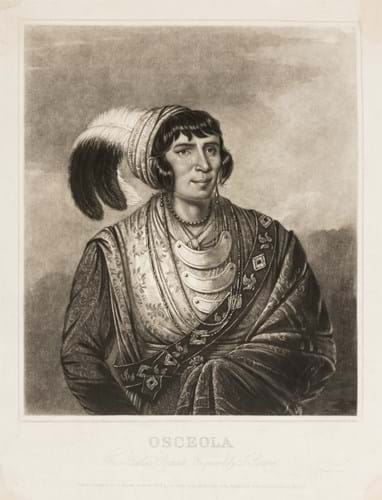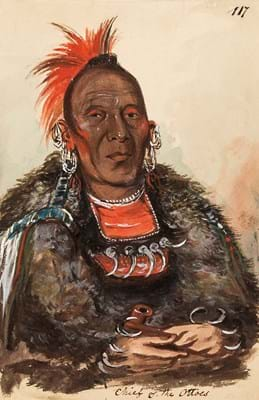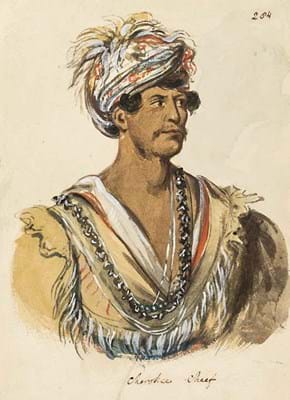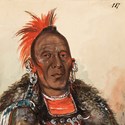The cache of 13 lots were consigned for sale on March 28 by descent from the family of the artist’s ‘dear friend’ Captain William Henry Shippard. Against a low estimate of around £23,000, they sold for over £150,000.
Catlin is considered the first white man to depict the people of North America in their native territory. During the 1830s, in the wake of Andrew Jackson’s controversial Indian Removal Act, he undertook five journeys west to paint the people who were at the time referred to by the white population as the ‘Plains Indians’.
Forced to sell
His finished works were exhibited in Catlin’s Indian Gallery that toured the US and European capitals in 1840. It was Catlin’s hope that the 607 pictures and artefacts would be acquired en bloc by the US government: however, in 1852 he was forced to sell to the industrialist Joseph Harrison.
The financial hardship that led to this painful decision (eased when Harrison’s widow donated The Indian Gallery to the Smithsonian) is documented in four pages of a letter written by Catlin to Shippard.
“Since the sudden and unexpected seizure of my collection, I have been using every effort I could to save it and to enable me to pay all the debts I owe… and as the only means of doing that, with the enormous costs now accrued my offers are before the Am[erica]n and the French Governments“. This desperate plea for assistance sold at £4000.
However, in financial terms at this Forum sale, the undoubted highlights of this album were two titled watercolour portraits of Plains Indians, each approximately 10 x 6in (25 x 15cm), probably produced by Catlin in situ in the early 1830s.
A c.1832 watercolour Wah-ro-néesah, The Surrounder, Chief of the [Otoe]Tribe with an estimate of £3000-5000 sold at £89,000 followed by Tuch-ee, A Celebrated War Chief of the Cherokees, sold at £38,000 (estimate £6000- 8000). Both lots were bought by an agent acting for a North American collector.

Osceola, a Catlin mezzotint published by John Sartain, New York 1838 with dedication note in pencil verso that reads 'Capt. Shippard. From his friend Geo. Catlin, 1842'. It sold at £6000.
Catlin produced fully worked oils of both sitters for his gallery. He probably painted Wah-ro-née-sah in 1832, while at Fort Leavenworth in modern-day Kansas, describing his subject as “quite an old man; his shirt made of the skin of a grizzly bear, with the claws on”.
He met Tuch-ee in 1834 after leaving Fort Gibson (Oklahoma) on a mission to establish contact with local tribes.
The buyer of both lots then bid £13,000 to secure a third portrait, a simple drawing titled La-wáh-he-coots-la-sháw-no, Brave Chief, a Skidi (Wolf) Pawnee probably produced for one of Catlin’s 11 ‘souvenir albums’ issued between 1852-68. Eight similar graphite studies were sold by Christie's in 2001 as part of the Malcolm Forbes collection.
While Catlin’s work is rarely available on the open market, subject matter is all important in terms of commercial worth. From the same collection a small watercolour and graphite portrait of a seated lady wearing a hat and smoking a pipe, possibly the artist’s wife Clara Bartlett Gregory Catlin, sold for a more modest £380 while other small landscape sketches sold in three rather than four figures.


















